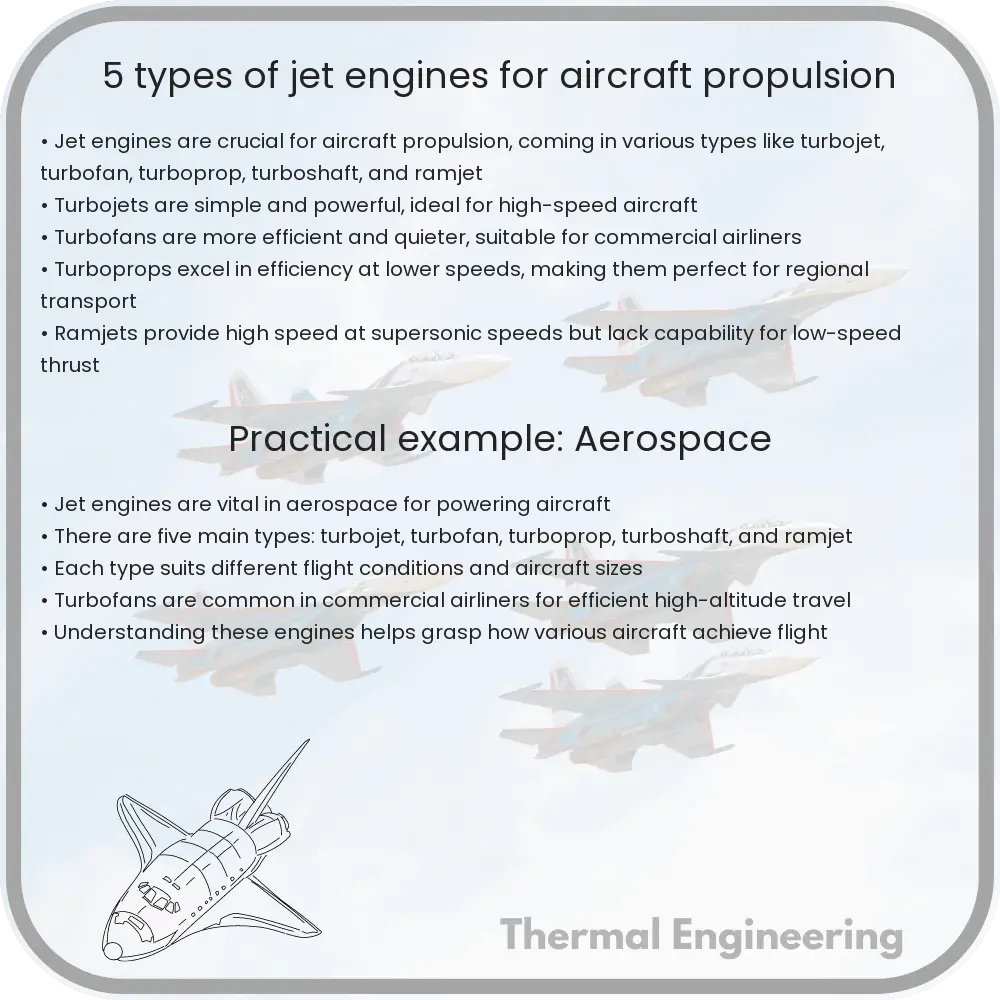Learn about the different types of jet engines powering modern aircraft, from turbojets to scramjets, each tailored for specific aviation needs.

Introduction to Jet Engines
Jet engines are the powerhouses behind modern aircraft, propelling everything from commercial airliners to military fighters through the skies. These engines harness the principles of thrust and Newton’s third law of motion, which states that for every action, there is an equal and opposite reaction. While all jet engines operate on the same basic principle—intake of air, compression, combustion, and exhaust—variations in design and function lead to different types of engines suited for specific applications.
1. Turbojet Engines
The turbojet engine is the simplest and earliest form of a jet engine that propelled the first generation of jet aircraft. It features a straightforward design that includes an air inlet, compressor, combustion chamber, turbine, and nozzle. Air is drawn into the engine, compressed by the compressor, mixed with fuel and ignited in the combustion chamber. The expanding gases flow through a turbine, causing it to spin, which in turn drives the compressor before exiting through the exhaust nozzle to produce thrust.
2. Turboprop Engines
Turboprop engines are a hybrid of jet engines and traditional propeller engines. These engines use a turbine to drive a propeller through a reduction gear, which provides thrust. Turboprops are highly efficient at lower speeds and are commonly used in smaller commuter aircraft, cargo carriers, and aircraft that require short takeoffs and landings. The energy in the exhaust gases is primarily used to drive the propeller, with only a small portion contributing to direct thrust.
3. Turbofan Engines
Turbofan engines are among the most commonly used engines in commercial aviation today. They are similar to turbojets but include an additional fan at the front, which allows for a larger volume of air to bypass the core turbine. Turbofan engines can be classified into high-bypass and low-bypass, depending on how much air bypasses the core. High-bypass engines, which propel most modern commercial jets, are preferred for their improved fuel efficiency and reduced noise levels compared to low-bypass turbofans, which are typically used in military applications.
4. Ramjet Engines
Ramjets represent a simpler form of jet propulsion with no moving parts. Air is compressed solely by the aircraft’s forward motion—hence the term “ram. Fuel is added and ignited in the combustion chamber, and the expanding exhaust gases generate thrust. Ramjets operate efficiently at high speeds (supersonic) but are incapable of operating at a standstill because they lack a mechanism to compress air at low speeds. Thus, ramjet-powered vehicles typically require an initial boost to reach effective operating speeds.
5. Scramjet Engines
Scramjets (supersonic combustion ramjets) extend the concept of ramjets to even higher speeds. They differ primarily in the way oxygen is used for combustion. While ramjets slow down the air to subsonic speeds for combustion, scramjets combust the airflow at supersonic speeds, which allows them to operate efficiently at hypersonic speeds beyond Mach 5. Like ramjets, scramjets also require assistance to reach operational speeds and are currently used predominantly in experimental or military applications.
Conclusion
The diversity of jet engines is a testament to the evolving field of aerospace engineering, reflecting ongoing advancements and adaptations to meet varying requirements of speed, efficiency, and performance. From turbojets to scramjets, each engine type serves a unique role, contributing to the broad capabilities of modern aircraft in both commercial and military domains.